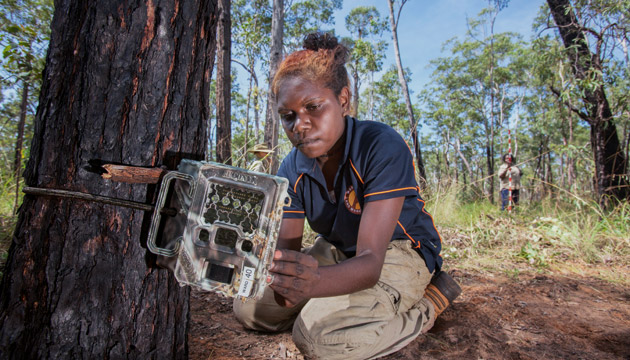Aboriginal land managers are using cutting-edge science to find out which threatened small animals remain on the rugged Arnhem Land plateau.
Story + Photos David Hancock
Scientists and Aboriginal landowners of Arnhem Land agree: the number of small to medium-sized mammals that inhabit the great wilderness of the Top End are rapidly declining.
Serina Namarnyilk, a traditional owner of country east of Kakadu National Park, used to see mayh (‘small animals’, in the Kunwinjku language of western Arnhem Land) everywhere when she was a child and her family regularly hunted possums and other creatures. “We used to find all those mayh but now they are gone somewhere, hiding,” she says. “Maybe they have been eaten by cats, or maybe they eat cane toads [and died], maybe it was the wildfires that used to come across from the east and south that scared them away.”
The decline follows extinctions across Australia. Native creatures were wiped out in waves following European settlement – hundreds of species of small animals and birds of Central Australia became extinct after less than a century of habitat degradation by humans and introduced animals.
Arnhem Land is one of the last great wilderness areas of the world, with unspoilt landscapes and virtually inaccessible country. The Aboriginal reserve covers 97,000 square kilometres and contains hundreds of endemic plant and animal species, some yet to be described by western science. However, since the 1970s, many native animals, such as the northern quoll and the black-footed tree rat, have drastically declined in Arnhem Land, and some, such as the northern hopping mouse, are now extinct on the Territory mainland.
Traditional owners from the Warddeken Indigenous Protected Area, which covers nearly 14,000sq km of the Arnhem Land plateau next to Kakadu, have launched their own project as part of the greater effort to understand why animals have become less common and what can be done about it.
Warddeken Land Management (WLM) has employed scientist Alys Stevens to undertake research that uses remote cameras to assess which animals remain and how many there are at 120 locations on the rugged plateau. The program builds upon a previous partnership between WLM and the Northern Territory Government, which gathered information about small animals over a five-year period through trapping and surveys. The data confirmed a decline of up to 95 per cent in the past 20–30 years in some areas.
“Greater minds than mine don’t fully understand why, but it is some kind of compounding and synergistic relationship between altered fire regimes, the spread of feral herbivores and pigs, feral cats, cane toads, weeds and possibly disease all contributing to widespread habitat degradation,” Alys says.
This story excerpt is from Issue #117
Outback Magazine: February/March 2018









